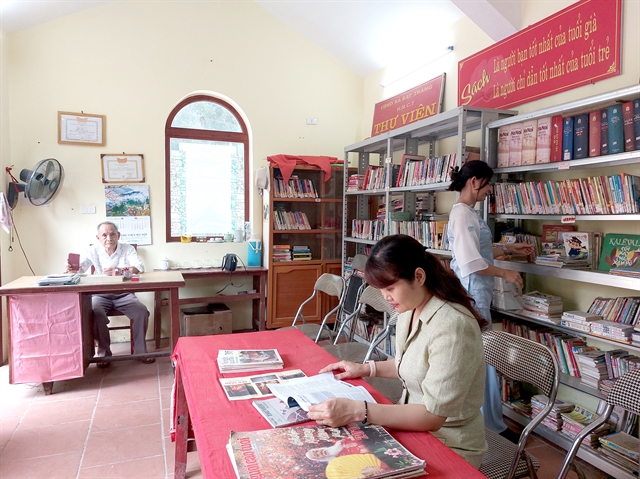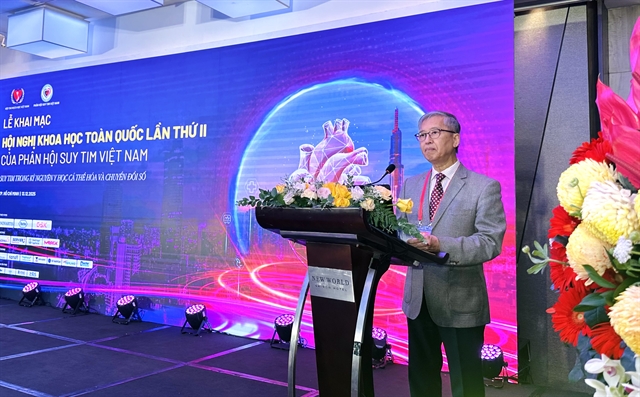 Society
Society

 |
| Giang Cao Hamlet Library in Bát Tràng Commune of Gia Lâm District, Hà Nội. — VNA/VNS Photo Đinh Thuận |
HÀ NỘI — Community-based libraries are considered crucial to building a rich reading culture among the people, but many of these facilities in Hà Nội are in need of transformation and support to attract readers and maintain their operations.
Bình Vọng Hamlet Library in Thường Tín District has more than 15,000 books of various genres, from socio-politics, education, lifestyle, culture and religion to science and technology.
A favourite destination among local residents, this library is considered a successful community facility in Hà Nội in multiple aspects, including mobilising resources, managing operations and community services.
Counting nearly 3,000 visits annually from readers within the area and from nearby neighbourhoods, the facility also welcomed various delegations to exchange knowledge and experience in library management, including one from the Swedish Royal Library.
Meanwhile, in the inner district of Tây Hồ, Hồ Khẩu Village Community Library is contributing to the abundant cultural activities in the city.
Initiating the reading space after her retirement, library manager Nguyễn Thị Tuyên worked with the district’s Centre for Culture, Information and Sports and people in the community to request support in management, operations and book contribution.
Hồ Khẩu Village Community Library now has nearly 7,000 books in its collection and is open two to three days a week.
It also regularly hosts displays of the spring edition of various newspapers, as well as book introduction events and other cultural activities.
The community library is running very well and attracts as many visitors as district-level libraries, according to librarian Nguyễn Thị Phương from Tây Hồ District’s Centre for Culture, Information and Sports.
More support needed
Hà Nội counted 1,096 community libraries as of 2023, with most of these small-scale reading rooms situated in local cultural houses of villages, residential areas, apartment buildings, and several in traditional communal houses and pagodas.
Community libraries in suburban districts often take advantage of the spacious areas available for a common reading room. But, the lack of space in inner districts means readers can only borrow books but typically have no space for onsite reading.
Most of the funding for community libraries in Hà Nội comes from private resources, except for a small number financed by the local authorities for book purchases such as the library of Yên Vỹ Village in Mỹ Đức District.
Many of these reading spaces suffered from the impact of COVID-19, one of them being Giang Cao Hamlet Library in Bát Tràng Commune of Gia Lâm District.
In 2019 and the previous years, the library sometimes had more than 100 visits per day.
Its collection also grew from the initial 300 books donated from the National Library, Hà Nội Library and Gia Lâm District Library, to over 5,000 volumes.
However, the number of visitors plummeted in the pandemic, said librarian Đào Ngọc Thụy who has been working at the hamlet library for two decades.
Giang Cao Hamlet Library now only opens on Thursday and Sunday to sustain operations.
According to Hà Nội Library deputy director Vương Thị Lý, increasing public engagement in cultural and educational activities is among the key solutions stated in the nationwide project “Developing reading culture in the community by 2020, with a vision to 2030.”
In order to maintain and grow the network of community libraries in the near future, the capital city’s library and related departments plan to carry out awareness campaigns to attract investment from the public to improve these reading spaces.
In addition to policy advisory and community engagement in building a reading culture at the grassroots level, the city and district libraries will also contribute to the local book collections to respond to the needs of the people and improve community library operations, she said. — VNS




